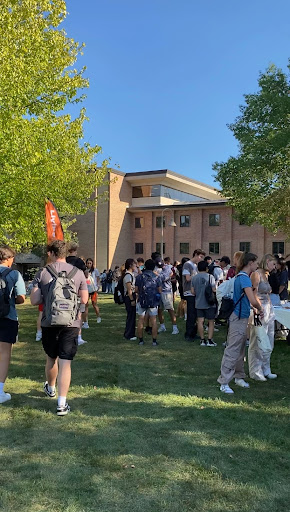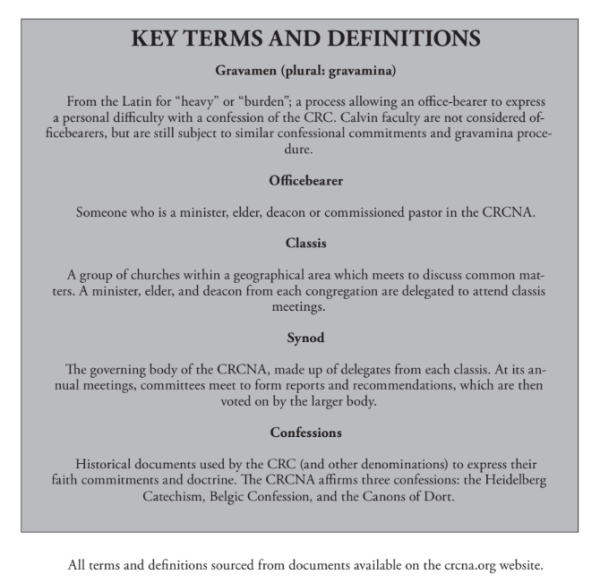Meeter Center opens new window on the Reformation
March 31st marks the final day of the “Here I Stand” exhibit in the Meeter Center. Photo by Mark Peless.
The Meeter Center and Calvin Theological Seminary are marking the 500th anniversary of the Reformation with lectures by Nicholas Terpstra of Victoria College, University of Toronto, and German Consul-General Herbert Quelle.
There is also the poster exhibit “Here I Stand,” which will be on display in the Meeter Center through March 31.
The lectures and exhibition explain the Reformation as a connection point for the wide variety of cultural and political movements that came before and followed the rise of Protestantism, calling attention to issues of prejudice, migration, refugees and the connection between political and religious movements apparent in the Luther’s era and today.
Terpstra’s lecture on March 9, titled “The Reformation of the Refugees: Forced Migration and the Meaning of Reformation,” explained how the Reformation participated in the creation of refugees and various expulsions of Jews and Muslims and, later, Catholics, and how the Reformers themselves and their followers experienced and responded to exile.
Terpstra noted that “we’ve always looked through the plate glass window, [the perspective of the reformation as the movement which created the Protestant tradition],” and encouraged his audience to “turn around to the side of the house and see if we see things differently in orientation and conjunction.”
Terpstra says his interest in studying the Reformation from a different angle began while he was working on a textbook project.
“The question for me as a teacher is, what is reformation for a new, global generation who are wondering how the 15th century has shaped the 21st?” said Terpstra.
Many reformers, notably John Calvin, experienced a period as refugees or were in permanent exile. “Purity, contagion and purgation” become themes in the reformers’ response to exile according to Terpstra. He notes that the stories of martyrs, the Exodus and Babylonian Exile narratives in the Bible became increasingly popular among Protestant refugees, particularly the Huguenots.
Many reformers took pride in their exile, as a mark of their unwavering commitment to spiritual purity. The reformers also participated in the concepts of contagion and purgation in the very idea of the reformation of the Catholic Church, seen as corrupt, and the persecution of other religious groups.
“This is where the concept of a religious refugee begins,” said Terpstra. Despite their own refugee experience, Terpstra pointed out that returned refugees are often more “partisan” and less inclusive.
After his lecture, Terpstra responded to a comment on how relevant his topic has become in light of current political events.
“It has been disturbing to me how relevant this topic has become,” Terpstra said. His new perspective on the Reformation makes it apparent that doctrines grown out of biblical ideas, such as a desire for a purity of life and doctrine, can have negative consequences.
Terpstra said the take-away from this sobering point is that, “Sometimes we have to be willing to realize we live in a … world … where people have taken doctrine in good ways and bad ways. … We should see Calvin as a refugee and Geneva as a refugee center … there is huge tension there … we have to be aware of those dynamics in our faith and in our political lives … we live in an unfolding world.”
Terpstra said the “positive challenge” for Christians engaged in the study of faith and its role in history and society is to “be more conscious of what happened in this period historically and how our faith is shaped by it.”
Terpstra also shared his own motivation for the study of a broader perspective on the Reformation. “I am interested in how people understand and apply their faith,” he said. “What are the impacts of our doctrine? … Surely there is a way to teach that does not divide, or if it divides, does not exclude.”
“Here I Stand” is a colorful poster exhibit on loan from Germany. It documents Martin Luther’s life, culture, era and impact. The posters display a variety of graphic styles from storytelling to statistical maps showing the spread of Protestantism in the U.S.
They help explain not only Luther’s role in the Reformation, but the Reformation’s role in the cultural and religious history of the world. The exhibit also doesn’t shy away from unflattering facts. One poster explains Luther’s prejudices and writings against certain religious groups, including the Jews and Anabaptists.
“Here I Stand” opens a wide new window on the Reformation, drawing a broad picture of its causes and impacts. Professor Karin Maag, the director of the Meeter Center, noted that her favorite posters in the exhibit are those which are, “like graphic novels … because they tell a story.”
Maag said they show the Reformation was not solely about “old men with beards and funny names.” She hopes that the exhibit and other events have impacted students by calling attention to themes in the Reformation which connected that era to this, themes of “toleration, refugees, church and state.”
Maag noted that these ideas cannot be applied directly from one era to another, but in the Reformation we “find roots which help explain … [and] understand what is happening now.”







